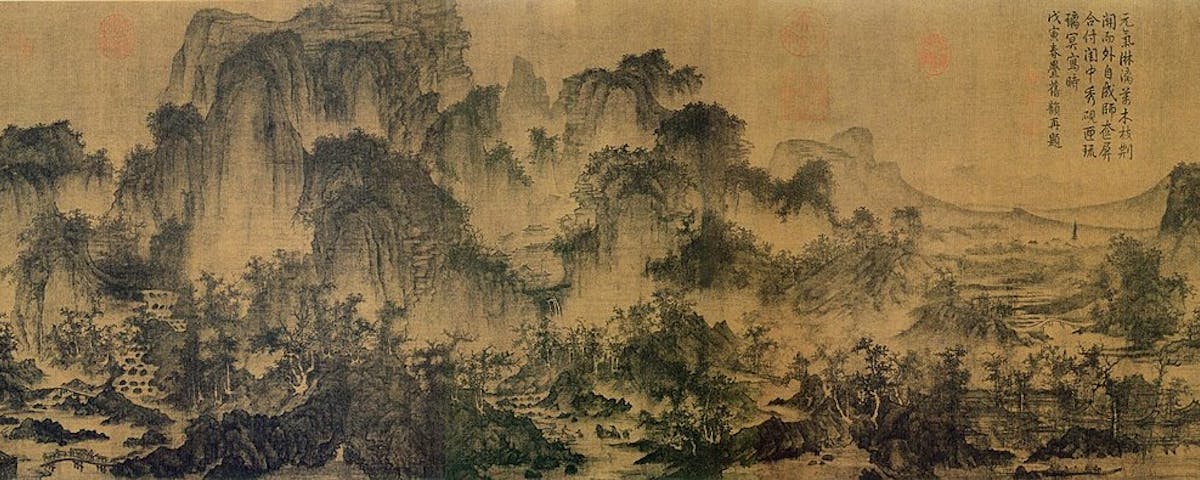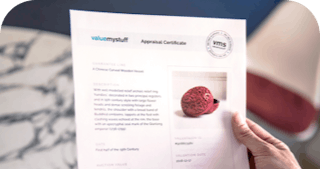Chinese Art Valuations
- Chinese Ceramic & Porcelain Valuations
- Jade Valuations

Whether it's a Chinese jade carving that's been passed down as a family heirloom or a Chinese vase that you found at a car boot sale, our experts can provide you with a valuation of your item, including their views on origin, date, and value. Within the last thirty years, Chinese art, whether it be ancient or contemporary, has flourished with regional and international collectors alike. Auction houses, including Christie’s, Sotheby’s, and Bonhams, have taken notice and responded to this demand by opening their branches in China. If you'd like to get a Chinese Art valuation from our online specialist, simply upload a photograph and tell us any other details you know about the item here!
What is Considered as Chinese Art?
What we consider as Chinese art today is visual art, ancient and modern, which originated or it was made or is practiced in a territory of Greater China, be it the People's Republic of China (PRC) and the Republic of China (ROC) or by Chinese artists. Art performed by Chinese artists overseas is also considered a part of Chinese art, especially if it’s based or connected to Chinese culture, heritage and history.
The earliest Chinese art artefacts dates back to the Stone Age, 10 00 BC, and consist mostly of pottery examples and simple sculptures. Later Chinese Art, as its history was typically classified by historians after a succession of ruling royal dynasties of Chinese emperors. Those periods usually lasted several hundreds of years and differentiate from each other stylistically. Below you can read more on the areas in which Chinese artists exceeded, and which find their place in most of the Chinese art collections all over the world.
How Much is Chinese Art Worth?
Chinese art, especially antiques, is highly sought after by collectors. Over the last decade, Chinese artefacts have been breaking records during the auctions. In 2016 Sotheby's sold a 18th-century Chinese teapot for $3.5 million in an Asia auction that raised more than $60 million in total.
There are both pros and cons for a high demand of Chinese art. It can definitely be an investment that will make a hefty return upon selling it, but the high demand also creates an increased number of fake items that already circulate on the market. To make sure that we own an authentic piece it is always good to turn to specialists such as our experts at Value My Stuff to confirm the value and origin of it.
How to Value your Chinese Art?
If you wish to check what your Chinese porcelain, wooden carvings, handscroll landscape painting, bronze Chinese coins or ancient buddha sculptures are worth, simply submit your online request to Value My Stuff here!
Fill in our online form with the information you have on your object and upload the good quality images of front and back side of your pice and underside, especially of porcelain piece, sculpture or furniture as there can be very valuable markings hiding. Take a closeup picture of any markings, signatures, but also damages of your piece, as all those information can influence the value of the piece. Once you gathered the information and images just send your request to us and we will forward it to our Chinese Art specialist.
Related: A Brief History of Chinese Art
Have something to value in Chinese Art?
Get your valuation in three simple steps!



Upload a photo
Upload a photo of your item



Item is valued
Experts value your item



Receive valuation
We send you your valuation
Antique and Modern Chinese Paintings
Chinese painting is one of the oldest painting traditions in the world. Traditional Chinese painting style is known as guó huà, and means “national painting” or “native painting”. Traditional Chinese painting involves the same technique as calligraphy and is performed with soft brush and ink or coloured pigments. Traditional painting is usually very light in the use of technique and material, as it’s usually made on paper and silk, and the oil paints are almost never used. Traditional Cinese paintings can also be performed on album sheets, walls, lacquerware and other media. Paintings on silk and paper can be mounted on scrolls, either hanging or handscrolls. The motives of traditional Chinese paintings are often landscapes, battles, mythological creatures etc. These paintings had various subject forms that included landscapes, battles, and mythological creatures, to name a few. These paintings were done on a variety of materials such as silk, stone, brick, and rock. The oldest known classical Chinese landscape painting is a work by Zhan Ziqian of the Sui Dynasty (581–618), Strolling About In Spring in which the mountains are arranged to show perspective.
Modern and contemporary Chinese artists often draw from the roots of Chinese art and mix traditional Chinese painting tradition with the western one, offering a so-called fusion art. Artist also began working with entirely new media. New motives and topics often enter the works of Modern Chinese painters who are expressing personal beliefs, national pride, and international awareness. One of the most famous and internationally acclaimed Chinese visual artists is Ai Weiwei, whose works are sought by collectors today. Other Chinese artists whose works are collected today are Zao Wou-ki, Qi Baishi, Zhang Daqian or Pan Yuliang to name a few.
Chinese Ceramics and Porcelain
Chinese ceramics, as other art forms in China has a long history. First examples of pottery known today were made during the neolithic period. Chinese quickly developed and perfected the firing techniques and building kilns. Wide range of clay enabled production of a variety of ceramic produce, from bricks and stoneware to more intricate porcelain dishes and finally sculptures.
A high demand on pottery products enabled the Chinese to quickly perfect the mass production process even when it came to the most delicate porcelain objects, which were later sent for export to Europe. Chinese porcelain was so valuable in Medieval Europe that it was called “white gold” and was often more valuable than the precious metal itself.
Chinese mastered the art of using coloured enamels on their porcelain vases, bowls and cups, creating themed ceramics we today classify as famille rose, famille verte or the whole sets covered in yellow, pink, green, blue or even black.
Most sought Chinese ceramics today are the ancient porcelain pieces marked with imperial seals, produced only for the ruling Emperors court. The quality of execution and intricate enamel paintings are the features every porcelain collector looks for, as well as sculptures of ancient diety, goddesses and buddhas.
Related: Looking At Famille Verte Chinese Porcelain
Chinese Wooden Carvings
Chinese had already mastered the art of carving wood before the rule of Qin dynasty (221–207 BC). Carving in intaglio (yinke, in relief (yangdiao , either raised or piercing through), and in the round (lidiao) all reached a highly developed state. Chinese woodcarvings can be found not only in furniture but also in architecture. They would describe highly decorated buildings as diaoliang huadong (with carved beams and painted pillars, for extreme, elaborate luxury).
Another area that Chinese showcased their woodcarving was of course sculptures of religious figures. Wooden buddha statues were found in all the temples in the country, as the religion thrived in China since the year 220.
Antique Chinese Bronze Coins
Chinese coins always varied in form and style from we usually know from th western culture. Especially sought today are the ancient bronze coins and other bronze items from the period of Xia Dynasty (around 2070 BC). The coins were cast in superior quality which is the reason for them being available for collectors even today. Bronze chess pieces and bronze seals from this period are also sought by collectors today.
Our Chinese Art Experts
Our expert specialises in Oriental art, including Chinese, Japanese and Korean. He worked for Spink and Son Ltd, founded in 1666 an auction company for antiques and collectibles, where he was director of the Oriental Department until 1995. He then left to set up his own business, offering select high quality items for direct purchase, and advising clients on the formation and disposal of specific collections.

